skip to main |
skip to sidebar
I'm not going to say this is an original idea, but - for me at least - it was inspired by the "keerai-kuzhambu" that happened fairly often when we were growing up. It was a generic name for a new dish born of the marriage of leftovers (basically, keerai (spinach) and whatever kuzhambu had been made - usually sambar or vetral kuzhambu) and served with pazhaya sadam (old cooked rice soaked in water overnight and made up the next day into a loose mix with buttermilk), or with dosas or idlis - but never with fresh rice, I guess we kids didn't think it deserved that accolade!
I've merely reprised the role of keerai-kuzhambu, as it were, by using vendhaya keerai (methi/fenugreek greens) instead of regular, to make fresh sambar. However, that didn't stop me from eating the sambar with curd rice.
Recipe for: Vendhaya keerai (fenugreek greens) sambar
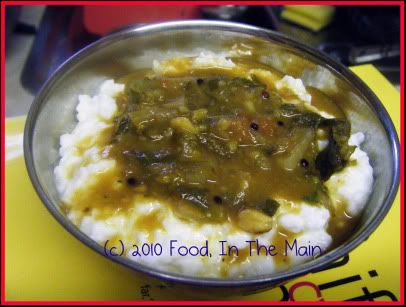
Ingredients:
1/2 cup toor/tuvar dal
2 green chillies, slit (optional)
Fresh methi (fenugreek greens), leaves and tender stems chopped finely
5-6 shallots, sliced thin
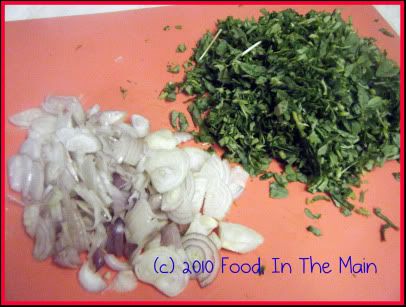
2-3 cloves garlic, minced
1 medium tomato, chopped
1.5 tsp tamarind paste dissolved in 4 cups water
2 tsp oil
1/3 tsp turmeric powder
1 small sprig curry leaves (6-10 leaves)
1 tsp mustard seeds
1/2 tsp cumin powder
1/4 tsp asafoetida powder (optional)
2 tsp sambar powder
1 tbsp rice flour
1 tbsp chopped coriander leaves for garnish
Method:
1. Pressure-cook the tur/tuvar dal 1.25 cups water, 1/4 tsp turmeric powder and two slit green chillies. Remove the green chillies after the dal is cooked, and mash the dal smooth.
2. Heat the oil in a deep-sided pan and add the curry leaves, mustard seeds, cumin powder and asafoetida powder. Cover and let the mustard seeds pop.
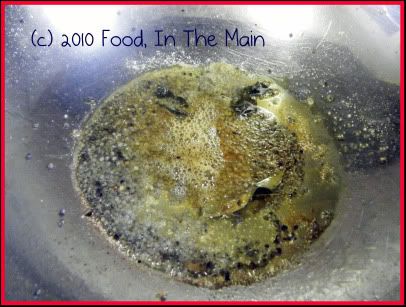
3. Once the mustard seeds have popped, add the sliced shallots and garlic. Cook over medium-high heat till the shallots start to soften.

4. Add the chopped tomato and let it cook till it begins to turn mushy.
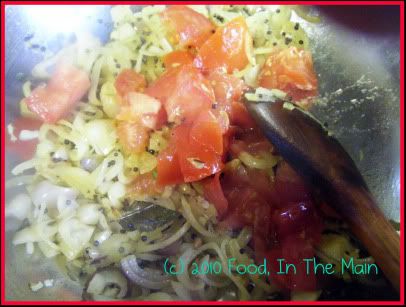
5. Now add the chopped vendhaya keerai (fenugreek greens) and stir till it's well mixed with the contents of the pan. Let it cook on med-low heat till completely wilted.
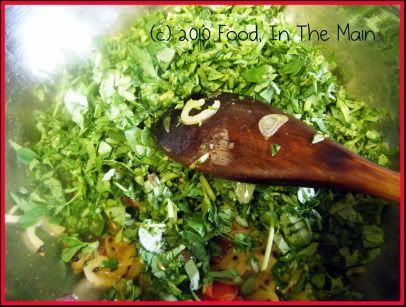
6. Now pour in the tamarind water and bring it to a brisk boil.
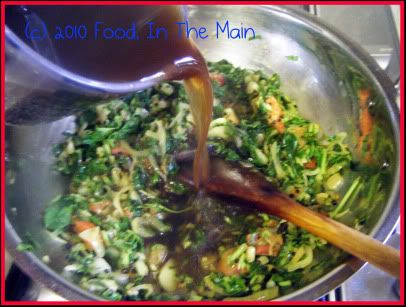
7. Once the water is boiling, add the sambar powder and mix it in.
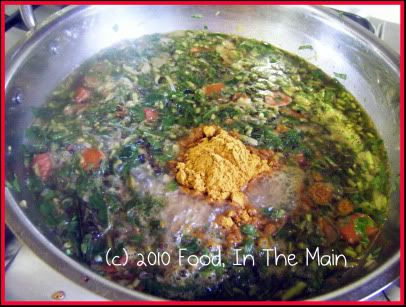
Let this boil for 10-15 minutes, then add the cooked tur/tuvar dal along with the rice flour dissolved in 4-5 tbsp water. Add salt to taste, bring the sambar back to the boil, then reduce the heat and let it simmer for another 5 minutes.
8. Sprinkle the chopped coriander and serve hot over plain rice, or as a side dish with curd rice.
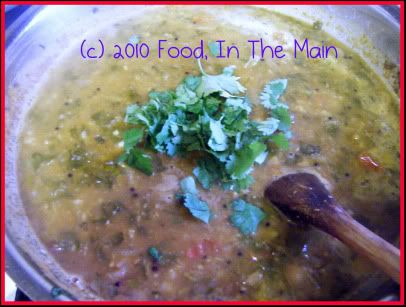
Soya protein nuggets aren’t exactly a thing of beauty, are they? They’re certainly not what I’d describe as “a joy forever”, either.
Once or twice I’ve tried soya protein – Nutrela, as I knew them in the 1990s – but I have to say that they’re very difficult to work with. The first time I experimented with Nutrela was to try out a recipe from some women’s magazine – it could have been Women’s Era, that weekly insult in printed form to women of all ages. The magazine’s articles were all uniformly irritating, a disservice to women’s emancipation every last one of them. The magazine also had recipes, and after trying their recipe for Nutrela, I realised that their cookery section was on par with their “advice” to women – pretty rubbishy, in other words.
I’m not certain now what exactly the recipe was for, but I think it was something Indo-Chinese(ish), without the addition of too much oil. A Manchurian-style starter, I think. I remember toothpicks being involved in the final consumption, so it can’t have been meant to be a gravy dish.
Whatever it was, I soaked the Nutrela in 2-3 changes of hot water and washed the spongy rounds and squeezed the excess water and did everything the recipe said to get rid of the weird taste of the soya chunks. But despite the addition of ginger and garlic and much frying - and, little by little, the addition of much more oil than specified – the soya chunks still tasted like soya chunks. I don’t know where all the seasoning and the masala went, or the oil for that matter, as the soya stayed spongy and never even came close to crisp. The soya tasted like soya, and that was that.
Not very encouraging in the way of cooking with Nutrela, I can tell you.
I know they’re meant to be a good source of protein, but I couldn’t help being reminded of a story written by William Hope Hodgson – “The Voice in The Night”, which I had read when I was 11 or 12 years old… it was a horror story, but not one with explicit descriptions of murder and torture. Rather, it was the subtlety with which the author conveyed the feeling of horror that took over my imagination and memory.
This isn’t a pointless digression, honest. The thing is, the look and feel of the nuggets once they were soaked and softened reminded me irresistibly (and not in a nice way) of the awful sponge/fungus mentioned in the story. That, of course, made me even less inclined to cook with Nutrela … and I didn’t, for many years, in fact.
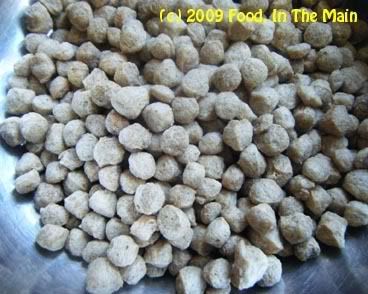
Last weekend I was at a Sri Lankan grocery shop in Wembley (Ganapathy Cash & Carry, for those who care) and among other things, I bought a small bag of soya nuggets. These weren’t the large boulder-type nuggets, they were more the size of peas – a lot less intimidating at that size and, I imagined, more likely to be edible. They didn’t remind me (much) of the grey nodding things, at any rate.
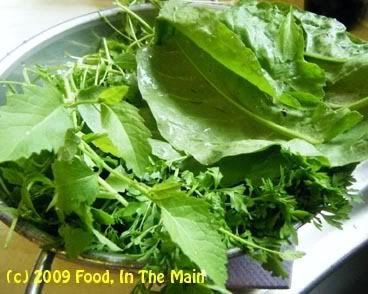
After all that, if you still like Nutrela and are still willing to read on for the recipe, I am not only surprised but also pretty pleased! I used three different kinds of greens to make the masala, but if you use only spinach, or a mixture of mustard greens and spinach, I don’t think it will affect the curry much. I don’t know if cress is meant to be cooked at all, but hey, there’s always a first time for everything. I don’t think it made a great deal of difference to the taste, in any case.
So, did I like this curry? To be honest, I personally would only give it a possible 6 out of 10 – but that’s because of the soya. The greens base was as good as it gets, and I’m certain the curry as a whole would go down very well with anyone who likes soya nuggets. But for those, like me, who can only muster a lukewarm liking for these spongeballs, it can only be a last-resort sort of dish.
Give it its due, though, when it was hot, the curry actually tasted quite good. But when I had some later in the day, the soya nuggets had done their usual trick of sucking up all the water content from the curry while leaving behind all vestiges of taste. Which meant that while they were “juicy”, not dried out, they also tasted only of soya, not the flavours of the masala. If somebody could explain why this happens – and more importantly, tell me how to prevent/redress this – they would have my eternal gratitude.
That said, I will still give the soya some more trials, perhaps in cutlets or some such preparation... at some point in the future.
Recipe for: Soya nuggets greens curry
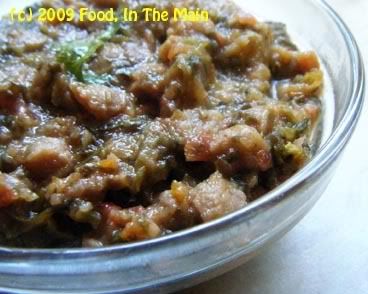
Ingredients:
1 cup small soya nuggets (or large ones chopped up)
2 small onions
3 medium tomatoes
1" piece ginger root
2 cloves garlic
1 tsp butter
1 tsp oil
2 cups assorted greens, sliced (I used mustard, cress and spinach beet)
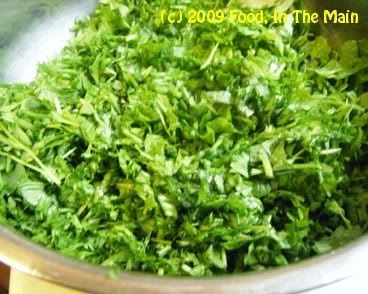
1 tbsp kasoori methi
1/2 tsp cumin seeds
1/4 tsp turmeric powder
1 tsp red chilli powder (or to taste)
3-4 green chillies, sliced thin
1/2 garam masala
1 cup milk
Salt to taste
Method:
1. Pressure cook the soya chunks with 1/4 cup water for 2 whistles.
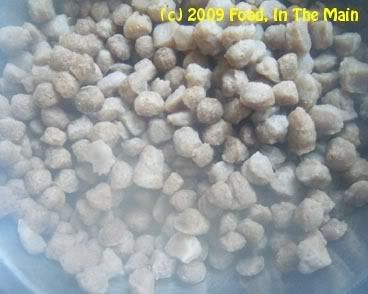
Wash the soya in a bowl of cold water, changing the water a couple of times. Then squeeze as much water out of the soya as possible and set aside.
2. Slice the onions thickly, put in a saucepan with a cupful of water, then bring to a boil.
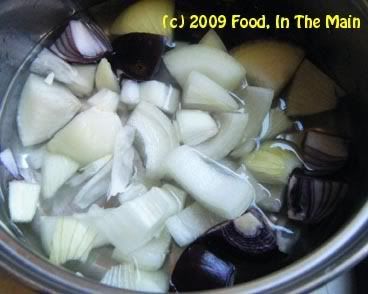
Simmer the onions for 5 minutes or till it turns translucent.
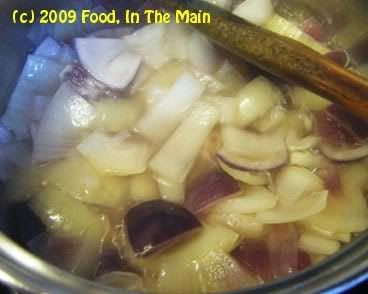
Drain any water that is left (you can use it to cook the greens in the next step).
3. Cook the sliced greens with 2-3 tbsp water, covered, till wilted. Mash the cooked greens roughly.
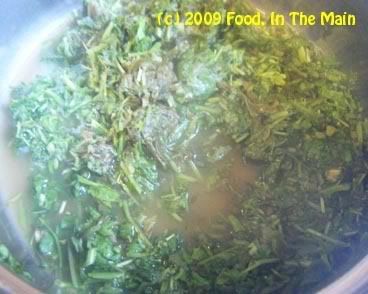
4. Grind the tomatoes, boiled onions, cumin seeds and ginger into a smooth paste.
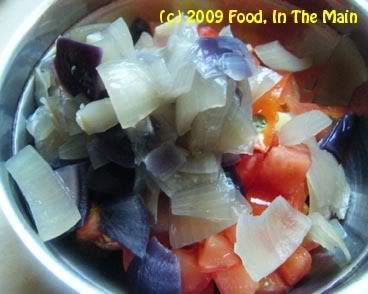
5. Heat the butter and oil in a pan and fry the sliced green chillies and garlic till the garlic begins to turn colour slightly.
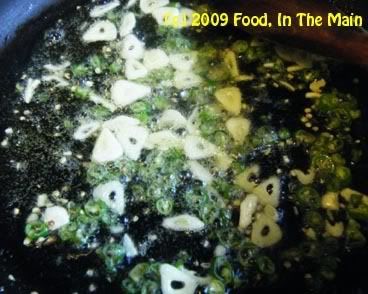
Do not let it get any darker. Stir in the garam masala, red chilli powder and turmeric powder.
6. Add the ground tomato paste and fry it for 4-5 minutes.
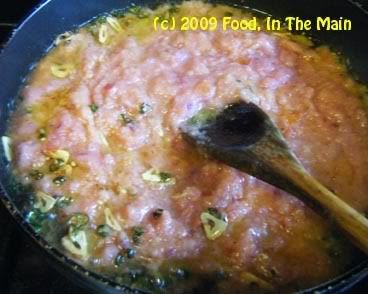
7. Now add the mashed greens
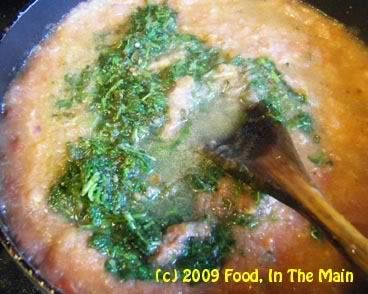
and mix it in well.
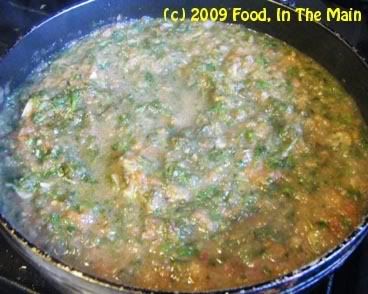
Pour in the milk along with 1 cup water,
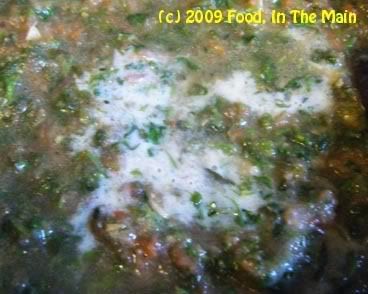
stir, and let the mixture come to a bubbling boil.
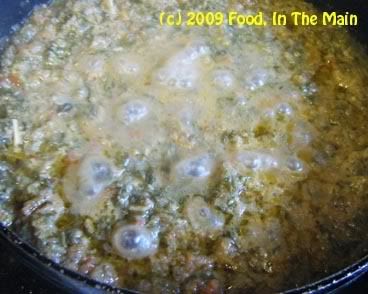
8. Add the soya nuggets now along with the kasoori methi and salt to taste, and stir it in.
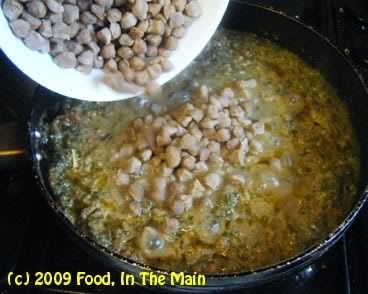
Let the curry simmer for 5-7 minutes, till the gravy is thick. Serve hot with chapaties.
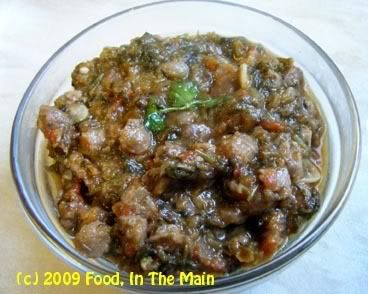
I love the combination of methi (fenugreek greens) with potatoes - there's something about the slightly bitter taste of the greens combined with the texture and flavour of lightly fried potatoes (first boiled and perhaps peeled) that really appeals to my taste buds. It's best if the greens are not fried to a crisp - just enough to wilt them, much like spinach.
So if you had the time and the patience to fry the greens separately and add them to the potatoes afterwards, when the spuds are beginning to acquire crispy bits, I would say that would be a pretty good thing to do. Alu methi is especially nice with chapaties and rotis, although I wouldnt object to it as a side with rice and sambar/any kuzhambu/rasam/curds.
Recipe for: Alu methi (potatoes with fenugreek greens)

Ingredients:
5-6 medium potatoes, boiled (peeling is optional) and cubed
2 cups methi, washed and chopped
2 tsp oil
Salt to taste
For tempering:
2 tsp mustard seeds
2 tsp urad dal
1/4 tsp asafoetida powder
1 tsp red chilli powder
1/2 tsp freshly ground black pepper
Method:
1. Heat 1 tsp oil in a small pan and add the chopped methi to it. Stir fry on high heat, until it is wilted, then remove from the heat. Reserve.

2. In a bigger pan, heat the remaining tsp of oil and add the tempering ingredients. Close the pan while the mustard seeds pop.
3. Put in the boiled, cubed potatoes and stir carefully to mix the ingredients, adding salt to taste. Dont break up the potatoes.
4. Let the potatoes fry over medium heat till they begin to crisp a little - spray them with oil if required.
5. When the potatoes are done to your liking, add the reserved methi and mix in carefully. Serve hot with chapaties or as a side dish with rice.
I like baking muffins - they're so quick and easy to do. Unfortunately I enjoy the baking part way better than the eating part, because of my under-developed sweet tooth. Pete likes muffins warm from the oven but once they cool down, they lie around neglected. And his kids, aged nearly 11 and nearly 13, dont like muffins at all - yeah, practically unbelievable, but true. So I dont do muffins nearly as often as I'd like to.
However, today I was in the mood. I had a basic recipe for herb and cheese muffins, so I decided to see what I could do with mostly Indian ingredients, but with a slight western touch. To that end, I picked about a cupful of coriander and fenugreek leaves. Then, because I didnt want to use cheddar cheese with those particular herbs (yep, methi leaves are classified under "herb" rather than "greens" for this recipe!) and didnt quite know what else to add, I rummaged around in my kitchen shelves to see what I could come up with.
That turned out to be a jar of whole-grain mustard with black pepper and white wine, with about a heaped tbsp remaining. Wondering all the time whether it was a good idea, I emptied out the mustard and added it to the batter. And still on an experimental note, I sprinkled parmesan cheese on some of the muffins, and added drained, chopped sundried tomatoes in oil to the rest, and set them to bake, hoping for the best.
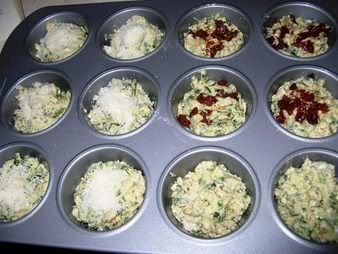
Boy oh boy, it turned out to be a tremendous success - Pete liked them (didnt bother trying them on the kids - they're SO resistant to anything different, it's amazing) although, since he was expecting sweet muffins, he was taken aback at first by the savoury flavour. But he agreed that they would be perfect with soup - or even parma ham (which combination he's welcome to try - I dont touch the stuff).
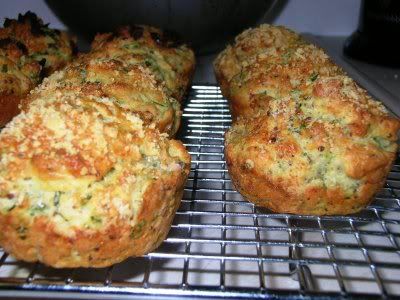
As for me, I absolutely loved the muffins! They would, as Pete said, be the perfect accompaniment to soup and salad for a light, healthy meal. If I can keep my hands off them before dinner, that is.
Next time I would probably add some chopped green chillies, because I think I would like the muffins even better with some added zing. Yummm....
Recipe for: Savoury methi-mustard muffins
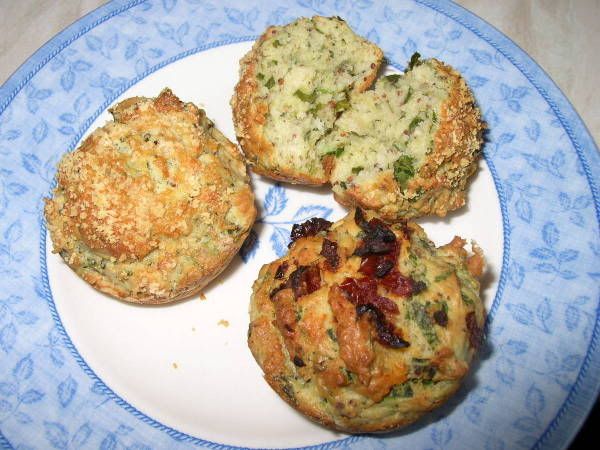
Ingredients:
2 eggs
1/4 cup butter/margarine
1/3 cup chopped fresh fenugreek leaves and coriander leaves
2 cups self-rising flour
1 heaped tbsp whole-grain mustard
1/2 tsp baking soda
1/2 tsp salt
3/4 cup low-fat/whole milk (use according to preference
Optional
3-4 tbsp parmesan cheese, grated
2 tbsp sundried tomatoes in oil, drained and chopped
Method
1. Pre-heat the oven to 180C (350F). Spray/grease a 12-cup muffin pan lightly with oil
2. In a medium bowl, beat the butter/margarine and mustard till well mixed
3. Add the eggs one at a time, beating well between additions.
4. Mix in the chopped herbs
5. Add the salt, baking soda, flour and milk to the batter and fold in quickly but gently till the ingredients are just mixed. Do NOT overbeat or the muffins will turn out tough
6. Spoon the batter into 6 of the muffin cups, leaving the tops rough. Sprinkle the tops with the parmesan cheese.
7. To the remaining batter, add the chopped sundried tomatoes, mixing lightly. Spoon the batter into the remaining 6 cups.
8. Bake for 20-25 minutes, or till the muffins are golden brown and done.
9. Serve warm as they are, or with soup and salad.
I love my greens - any greens, which is a quantum change from when I was younger. But I cant really tell them apart, taste-wise, unless it be the sour-sharp tangy "gongura", which is an Andhra specialty (as demonstrated deliciously by Indira in her blog). I wish I could get gongura here. The Indian grocery market in Birmingham does not run to quite such regional varieties, unfortunately.
My mother used to buy "ara keerai" and "mola keerai" from the local travelling vendor, claiming that the two were different in taste - but I could never tell them apart, either in looks or in taste. "Saag" and "palak", North Indian varieties of spinach, are interchangeable as well, to me. If I cant get these known Indian greens, I'm happy to settle for the generic "greens" available in the English supermarkets. I honestly dont find them any different when used in dals or cooked, mashed and seasoned in the Tamil way.
Today, though, there was fresh saag (or it could have been palak), courtesy of a foray to the Birmingham shops, and some of my very own home-grown fenugreek greens (yessss!), so I decided to make saag-paneer. And then while rummaging in my cupboard, I found a nearly empty pack of pink masoor dal - it came to about 1/2 cup. It didnt seem worthwhile to store such a small amount or transfer it to a tin, so I decided to use it up.
Voila! - saag paneer with masoor dal.

The cupful of fenugreek greens (methi) added to the saag provided the winning touch, because the final result was just mouth-wateringly tasty. I do love my methi! And the 1/2 cup of masoor dal, cooked, was just enough to hold together the rest of the ingredients, making it unnecessary to add any cornflour or rice-flour as a thickener. And boy was it tasty! Masoor is one of my favourite dals because it cooks so quickly. I've always though it a bit of a shame, though, that the pretty salmon pink colour disappears when the dal is cooked - it turns yellowish instead.
Oh, and the best part of this dal - the only fat content is from the paneer. If you use low-fat paneer, so much the better!
Recipe for: Saag-paneer with masoor dal
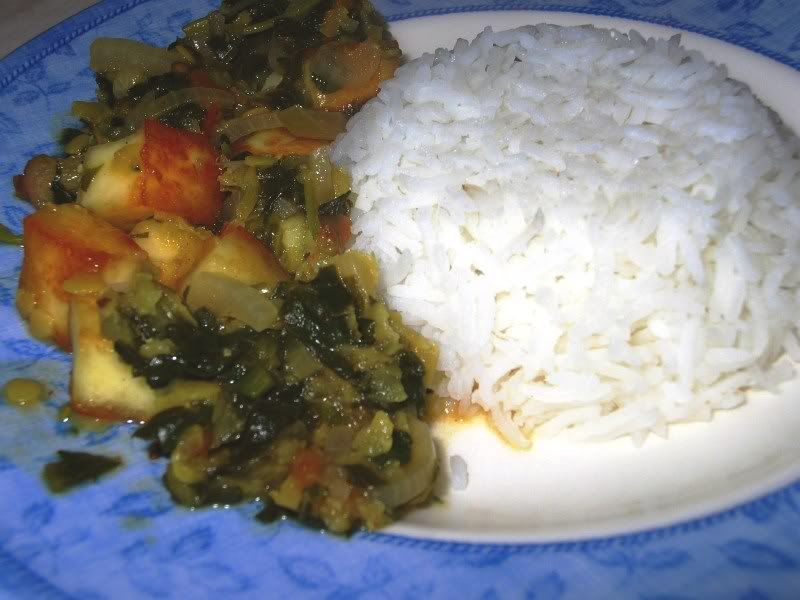
Ingredients:
1 bunch fresh spinach leaves, cut into strips
1 cup fresh methi (fenugreek) leaves, chopped
1 large onion, sliced thin
2 large ripe tomatoes, chopped
200 gm paneer, cubed and lightly stir-fried in a tsp of oil
3 green chillies, chopped fine (optional)
1/2 tsp red chilli powder (optional)
1/2 tsp garam masala or chana masala
2 large cloves garlic, chopped
3/4 cup pink masoor dal
1/2 tsp turmeric powder (optional)
Low-fat cooking oil spray
For tempering:
1 tsp oil or ghee
1/2 tsp garam masala
1 heaped tsp cumin seeds
2 dried red chillies, broken in half (optional)
Method:
1. Wash the masoor dal and cook it in about 1-1/2 cups water mixed with the turmeric powder, till it's done but not mushy. (Remove any froth with a spoon). Drain the water and reserve (about a cupful).
2. In a wide pan, heat the tsp of oil and add the garlic and chopped green chillies (if using). Stir-fry for 30 seconds, then add the sliced onions. Squirt the onions with a couple of sprays of cooking oil. Fry till the onions start turning brown.
3. Add the chopped tomatoes and cook for 2-3 minutes, then add the chopped greens. Sprinkle 3-4 tbsp of the reserved dal-water over the greens. Cover the pan and cook for 5-6 minutes on medium-low, until the greens are wilted and cooked.
4. Now add the red chilly powder (if using), the cooked masoor dal and the rest of the dal-water and mix well. Add salt to taste.
5. Add the lightly fried, cubed paneer and simmer the dal for 4-5 minutes.
Seasoning:
Heat a tsp of oil/ghee in a small pan, add the dry red chillies (if using) and the cumin seeds. When the seeds change colour and give off a nice aroma (a few seconds), add 1/2 tsp of garam masala and take the pan off the fire. Pour this seasoning over the surface of the dal and serve hot with plain steamed rice and microwaved papad.


































